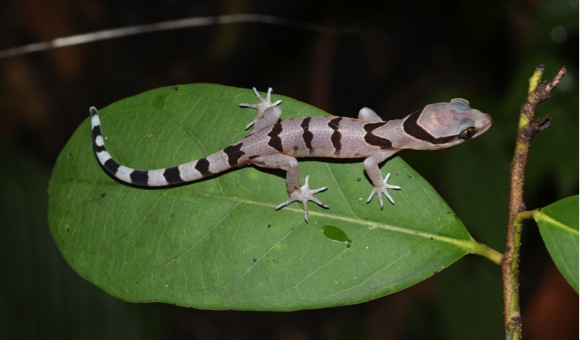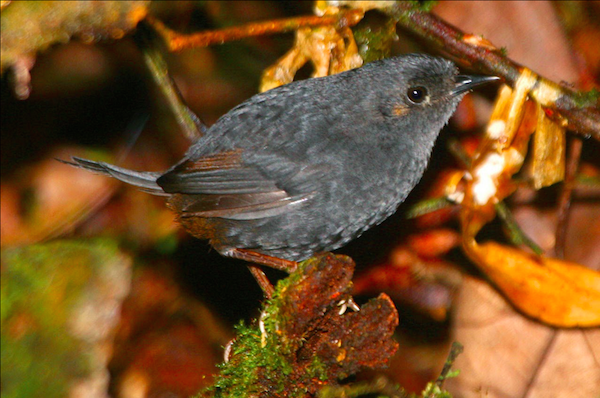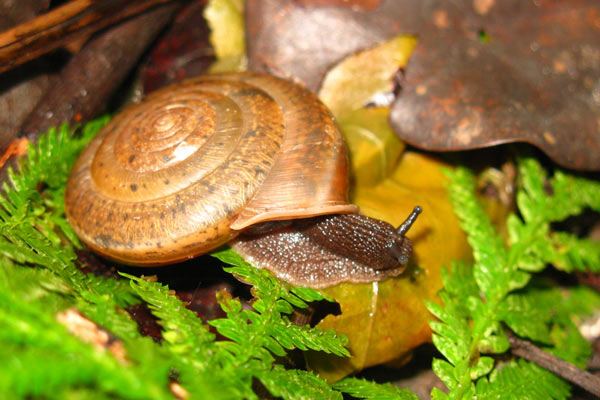Part I of II. See Part II

The Ankarafa skeleton frog was described in the summer of 2014. The frogs are called ‘skeleton’ because of their semi-transparent skins. Photo by: Gonçalo M. Rosa.
Seemingly every year scientists set a new record with the number of species they describe. 2014 will be no exception.
Below are some of the “new species” highlights from the past year. The list includes species whose descriptions were first published in 2014. Some of the “discoveries” occurred in years prior.
Many of the species described for the first time during the past twelve months are “cryptic species” — species that were officially distinguished from similar-looking and closely-related species using genetic analysis. However some of the discoveries are totally novel to science.
Note: for each entry, the author of the original Mongabay.com post is listed in parentheses.
New pit viper discovered in Sumatra (Moreno)

An adult female T. gunaleni in Sumatra. Photo by G. Vogel.
Writing in Amphibian & Reptile Conservation (amphibian-reptile-conservation.org), Gernot Vogel, Patrick David, and Irvan Sidik described a new pit viper from mountainous forests in Sumatra. The viper, named Trimeresurus gunaleni, was identified by the researchers while they were studying a group of Trimeresurus sumanatrus, first described by Sir Thomas Stamford Raffles in 1822.
“It’s a surprising finding,” Dr. Vogel told mongabay.com, “as [the new species] is a large viper, very colorful and superficially different.”
While Sumatra’s rainforests are disappearing rapidly, Trimeresurus gunaleni isn’t particularly threatened due to the remoteness of its habitat.
Striking new gecko discovered in Thailand (Parkman)

Juvenile Sai Yok bent-toed gecko (Cyrtodactylus saiyok). Photo by N. Panitvong.
A research team based in western Thailand has discovered a new gecko species in the Kanchanaburi Province, a region renowned for its number of species found nowhere else in the world. A recent publication in the journal Zootaxa describes the Sai Yok bent-toed gecko (Cyrtodactylus saiyok), likely the sixth reptile species endemic to the region known to science.
“No other area of Thailand houses as many reptile endemics,” coauthor Dr. Oliver S. G. Pauwels, a tropical reptile specialist who has described four of these endemics, told mongabay.com.
The site at which the species was first identified consists of a limestone hill covered in dry evergreen and bamboo forest. Named for the district in which it was discovered, the Sai Yok bent-toed gecko was found exclusively on small trees, stumps, and plants in the Araceae family, which includes rhododendrons. It is pale brownish gray over much of its body, with bluish pigment surrounding its eyes and dark bands encircling its tail and body. It’s quite small, with a maximum length of just over six centimeters (2.4 inches).
The main identifying trait that distinguishes the Sai Yok bent-toed gecko from other Cyrtodactylus species lies in the presence of its enlarged thigh scales.
New tapaculo bird species discovered in Brazil (Gaworecki)

The Bahian mouse-colored tapaculo (Scytalopus gonzagai). Photo by Ciro Albano.
A newly described bird species from Brazil’s Mata Atlantica is already classified as endangered. The Bahian mouse-colored tapaculo (Scytalopus gonzagai) was distinguished from the closely-related the mouse-colored tapaculo in a paper published in The Auk.
Scylatopus is a genus of small songbirds in the family Rhinocryptidae that are found mainly in mountainous regions throughout South and Central America, from Tierra del Fuego to Costa Rica.
Surprising poison dart frog discovery (Stewart)

The holotype specimen, which scientists used as the basis to describe a new species of poison dart frog: Andinobates geminisae. Photo by: Cesar Jaramillo, STRI.
It was a surprising discovery in an unlikely location. In a leaf litter nearly four inches deep under a dense canopy of rainforest trees, researchers Marcos Ponce and Abel Batista with the Universidad Autónoma de Chiriquí worked to complete an inventory of endangered species in Panama’s Isthmian-Atlantic moist forest. But they were both completely unsuspecting of what they were about to find: a new poison dart frog.
Because of their eye-catching colors and toxicity, poison dart frogs are some of the most well known amphibians. Most poison dart frogs prefer flat, moist, low-lying areas and can be found under the protective cover of rocks and logs. So when Ponce and Batista discovered the first specimens of Geminis’ poison frog (Andinobates geminisae) on high ground, it was indeed a surprise discovery.
“Abel Batista and Marcos Ponce were the first to note the presence of this species,” said Cesar Jaramillo, herpetologist with the Smithsonian Tropical Research Institute (STRI) and co-author of species description in Zootaxa. “They’ve known it was there for several years. However, they were not sure if it was only a variety of another poison dart frog species, Oophaga pumilio, which exhibits tremendous color variation. Based on morphological characteristics of the adult and the tadpole, I thought it might be a new species of Andinobates geminisae.”
So far the new species has only been found in the Río Belén basin in areas of untouched forest. All of these frogs have been seen on ridges of small hills indicating that this particular species prefers higher, drier areas in sharp contrast to its counterparts.
New gecko in Madagascar (Butler)

Juvenile and subadult of the new species Paroedura hordiesi. Credit: Jörn Köhler.
In November researchers described a previously undocumented species of gecko from Madagascar. Due to its limited range — limestone massifs in the northern part of the Indian Ocean island nation — and threats to its habitat, the authors recommended Paroedura hordiesi be immediately classified as “Critically Endangered” on the IUCN Red List.
The species was described in the open access journal Zoosystematics and Evolution.
Snail becomes gay rights symbol in Taiwan (Hance)

The new snail named after the struggle for same-sex marriage: Aegista diversifamilia. Photo by: Chih-Wei Huang.
Scientists have named new species after celebrities, fictional characters, and even the corporations that threaten a species’ very existence, but a new snail may be the first to be named after a global human rights movement: the on-going struggle for same-sex marriage. Scientists have named the new Taiwanese land snail, Aegista diversifamilia, meaning “diverse human families”.
“When we were preparing the manuscript it was a period when Taiwan and many other countries and states were struggling for the recognition of same-sex marriage rights. It reminded us that Pulmonata land snails are hermaphrodite animals, which means they have both male and female reproductive organs in single individual,” explained co-author Yen-Chang Lee. “They represent the diversity of sex orientation in the animal kingdom. We decided that maybe this is a good occasion to name the snail to remember the struggle for the recognition of same-sex marriage rights.”
Same sex marriage is currently not legal in Taiwan, and a bill in the government proposing to legalize same-sex marriage has been stalled by the Parliament’s judiciary committee since October 2013. A recent rally in favor of legalizing same-sex marriage in the country attracted thousands.
The new land snail that celebrates “diverse human families,” was split from another land snail described in 1884: Aegista subchinensis. For over a century, scientists thought this species was found across Taiwan, however in 2003 Lee noticed that the eastern population of Aegista subchinensis had a larger and flatter shell.
Analysis reveals 5 new species of saki monkeys (Hance)

The aptly named monk saki monkey in Colombia (Pithecia monachus). A new review uncovers five new species in this largely-mysterious primate group. Photo by: Rhett A. Butler.
While saki monkeys may be characterized by floppy mops of hair that resemble the worst of human toupees, these acrobatic, tree-dwelling primates are essential for dispersing seeds across the vast Amazon landscape as they primarily dine on fruit. After long being neglected by both scientists and conservationists, a massive research effort by one intrepid researcher has revealed the full-scale of saki monkey diversity, uncovering five new species.
Laura Marsh, the director and co-founder of the Global Conservation Institute, spent ten years studying the saki monkey family, which make-up the genus Pithecia.
“I began to suspect there might be more species of saki monkeys when I was doing field research in Ecuador,” Marsh said who published her findings in Neotropical Primates, which is published by the IUCN’s Species Survival Commission’s Primate Specialist Group and Conservation International (CI).
“The more I saw, the more I realized that scientists had been confused in their evaluation of the diversity of sakis for over two centuries.”
During the 18th and 19th centuries, scientists discovered seven saki monkey species; four more were named in the twentieth century, for a total of 11 species. But Marsh’s study, which runs to over 160 pages, increases the family’s diversity by 45 percent for a grand total of 16 proposed species.
Scientists honor missing activist with a spider (Butler)

Aposphragisma brunomanseri goblin spider. Courtesy of the Natural History Museum of Berne
Swiss researchers have honored the memory of a missing indigenous peoples activist by naming an undescribed species of spider after him, reports the Bruno Manser Fund, the group he founded.
Bruno Manser, an environmentalist who campaigned on behalf of the nomadic Penan people and the rainforests of Malaysia Borneo, went missing in 2000 after years of conflict with authorities in the state of Sarawak. He would have turned sixty on Monday.
The newly described spider is christened Aposphragisma brunomanseri.
Scientists pressure mining company by naming endangered snail after it

Various views of the shell of the new snail species named after Lafarge. Photo courtesy of Vermeulen et al.
Scientists have discovered a new snail species on a limestone hill near a cement quarry in Malaysia, which as far as they know lives nowhere else in the world. The animal’s shell is only one tenth of an inch in size.
“Narrow endemic species are a common occurrence on limestone hills,” Jaap Vermeulen, lead author of the new study, told mongabay.com. “A good biologist can quite easily discover several species of endemic invertebrates on an isolated, unsurveyed hill.”
Although just unearthed, the miniscule snail is already threatened with extinction. It lives on Kanthan, a limestone hill given as a concession to mining company Lafarge. The cement producer quarries the hill for raw materials. As a result, the snail will be included as “Critically Endangered” in the next update of the IUCN Red List for Endangered Species.
The scientists who discovered the animal named it Charopa lafargei, after the cement company that will decide its fate.
“I’m not aware of a species threatened with extinction which has been given the name of the company which can determine whether it goes extinct or survives,” said Tony Whitten from Fauna & Flora International.
The new snail is not the only endemic species found on the hill. Kanthan is also home to nine plant species that are on Malaysia’s Red List of Endangered Plants, one Critically Endangered spider (Liphistius kanthan), one gecko (Cyrtodactylus guakanthanensis) and two snails (Opisthostoma trapezium and Sinoennea chrysalis) that are found nowhere else in the world.
A new skeleton frog from Madagascar

Ankarafa skeleton frog’s (Boophis ankarafensis) mating. Photo by: Gonçalo M. Rosa.
Sometimes all it takes is fewer clicks. Scientists have discovered a new species of frog from Madagascar that stuck out in part because it “clicked” less during calls than similar species. Unfortunately the scientists believe the new species—dubbed the Ankarafa skeleton frog (Boophis ankarafensis)—is regulated to a single patch of forest, which, despite protected status, remains hugely threatened.
“All individuals were detected from the banks of two streams in Ankarafa Forest,” the researchers write in the paper, adding that “despite its conspicuous call, it has not been detected from other surveys of northwest Madagascar and it is likely to be a local endemic to the peninsula.”
The Google Earth chameleon (Butler)

At around 7-8 cm long, the Mount Mabu pygmy chameleon (Rhampholeon maspictus) is a relatively large species. Its name comes from the Latin for ‘painted man’, reflecting the striking green, blue and yellow coloration of breeding males. Image credit: William R. Branch, caption courtesy of Fauna & Flora International
Google Earth has spurred the discovery of another new species.
In this case, the creature is a pygmy chameleon, one of four previously unknown Rhampholeon chameleon species described from the remote ‘sky islands’ in Mozambique. The Mount Mabu pygmy chameleon (Rhampholeon maspictus) was discovered after Google Earth images of a tract of forest led Julian Bayliss, a consultant for Fauna & Flora International, to launch a scientific expedition to the region.
The Mount Mabu pygmy chameleon is described along with three other species — the Chiperone pygmy chameleon (Rhampholeon nebulauctor), the Mount Namuli pygmy chameleon (Rhampholeon tilburyi), and the Mount Inago pygmy chameleon (Rhampholeon bruessoworum) — in a recent issue of the journal Zootaxa. The species were distinguished using DNA analysis.
Mount Chiperone, Mount Inago, Mount Mabu and Mount Namuli are part of the Afromontane Archipelago, a series of mountain chains and isolated mountains that runs the from Ethiopia to South Africa.
New millipede species threatened by mining in Madagascar

The head of a female Sphaeromimus vatovavy, one of the new species described. Photo courtesy of Wesener et al., 2014.
A team of scientists from the United States and Germany has recently described seven new species of Malagasy giant pill-millipede. All but one of these species are considered “microendemics,” in that they have only been found in small, isolated forest patches. The study was published in ZooKeys earlier this year.
The species are all of the genus Sphaeromimus – which means “small ball animal” – and are unique because they contain larger “stridulatory” organs than any other millipedes. These allow the millipedes to make a chirping noise by rubbing body parts together. Although little is known about the purpose of stridulation in millipedes, it was previously hypothesized by the lead author of this study, Thomas Wesener of the Research Museum Alexander Koenig in Germany, that the millipedes are performing mating calls while chirping.
Although Sphaeromimus millipedes are only found in an area less than a few hundred kilometers wide at the southern tip of Madagascar, they vary greatly in terms of habitat type and genetics.
“The Sphaeromimus millipedes [S. splendidus and S. saintelucei] we collected in the littoral rainforest of Sainte Luce were two different species, that are genetically not even closely related, living in fragment S9, a conservation zone, and S8,” Wesener said. “Both [conservation zones] are only a few hundred meters apart, but seem to have a different soil.”
However, titanium mining threatens the little habitat available to the millipedes.
Colorful frog discovered in Malaysia (Barrett)

The new frog species, Hylarana centropeninsularis. Photo by Chan et al.
Scientists have identified a new species of frog on the Malay Peninsula. The newly named Hylarana centropeninsularis was discovered in a peat swamp and genetic analyses revealed that it is evolutionarily distinct from its stream-dwelling cousins.
After publishing the discovery in the online journal Herpetologica, Kin Onn Chan, a doctoral candidate at the University of Kansas, told mongabay.com that the frog was actually first found 10 years ago.
“An ex-student of my ex-advisor at the National University of Malaysia collected it in one of her pit-fall traps… After digging through historical records and literature, we found that it was not the first time that that particular ‘species’ had been found,” Chan said.
Part I of II. See Part II